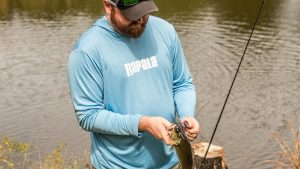Low-water levels, often seen in late summer and fall, can create unique challenges for anglers fishing from the bank of a public lake or pond. Droughts and water drawdowns can expose traditional cover and leave favorite fishing spots dry. However, with a few strategic adjustments, it’s still possible to catch fish. Here are five tips to improve success when fishing in low-water conditions.
1. Get Closer to the Water
In normal water levels, anglers would typically stay further back from the shoreline. However, with lower water levels, getting closer can make a significant difference. Bass often move with the water, and during low-water conditions, they tend to stay in deeper areas, further from the shore. Observing the shoreline for signs of life, such as baitfish or bluegill, can help determine the best spots to fish. If there’s little activity in the shallows, it’s a good indication that bass have moved deeper.
With traditional cover now exposed, making longer casts is essential to target submerged trees, depth changes, or underwater vegetation. Getting closer to the water allows for more accurate and effective casting in these areas.
2. Focus on Casting Angles
When fishing in low-water conditions, paying attention to casting angles is crucial. One key observation is the old waterline on the bank, which often indicates where fish may be holding. Casting 10 to 12 feet beyond visible shoreline cover helps target fish that have moved to deeper water.
Bass tend to sit on the first depth change, or “break line,” away from the bank. These break lines act like steps in the water column, providing fish with both security and an opportunity to ambush prey. Casting to these break lines increases the chance of success, as bass use them to corral baitfish and move along the structure.
3. Topwater Lures Are Effective
In low-water conditions, bass often suspend in the water column, neither at the surface nor near the bottom. Because bass prefer to feed upward, topwater lures can be incredibly effective. When water temperatures are above 55 degrees, topwater lures such as soft-plastic toads or hollow-bellied frogs are excellent choices.
These lures allow bass to strike from their suspended position and create exciting fishing action. By focusing on topwater techniques, anglers can take advantage of bass behavior in low-water environments.

4. Make Repeated Casts
Low-water conditions can sometimes put bass in a lethargic state, making them less likely to bite. However, repeated casts to promising cover can trigger a reaction bite. It’s one of the few scenarios where persistence and stubbornness can pay off.
Bass don’t always bite out of hunger. Sometimes, repeated presentations can irritate them enough to strike out of aggression. This method can be particularly effective when targeting isolated cover that remains submerged after a water drawdown.
5. One Bite Can Lead to More
In low-water conditions, cover becomes scarce, making any remaining submerged cover prime real estate for bass. Once a bite occurs, it’s essential to act quickly. Bass often congregate in the same area, competing for space and food. This competition can create more aggressive behavior, leading to multiple catches in the same spot.
Once a bite is detected, unhook the fish quickly and get the lure back in the water. The odds of catching more bass in the same area are high, especially around submerged cover like laydowns or vegetation patches.
Low-water conditions may present challenges, but they also offer unique opportunities for anglers willing to adapt. By getting closer to the shoreline, adjusting casting angles, using topwater lures, and making repeated casts, it’s possible to have productive fishing days even when water levels are low. Staying persistent and aware of bass behavior can turn challenging conditions into a rewarding fishing experience.
Image/Source: Wired2Fish





